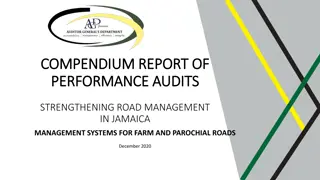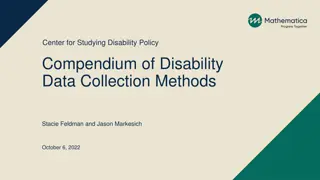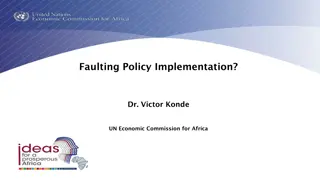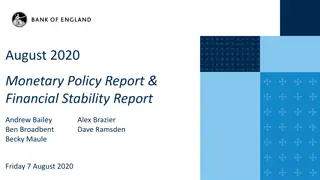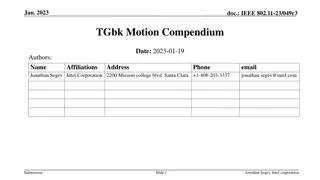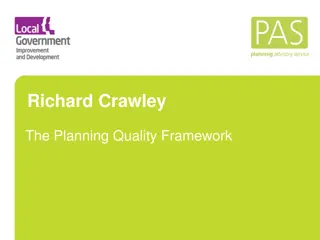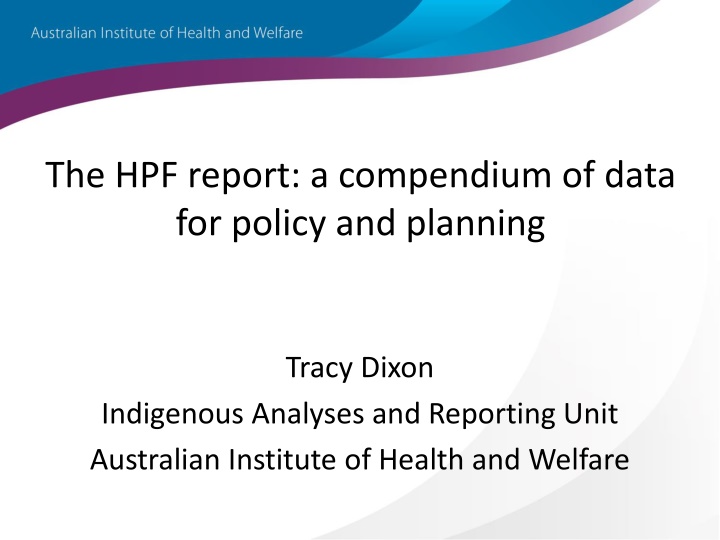
Aboriginal and Torres Strait Islander Health Performance Framework
Explore the Aboriginal and Torres Strait Islander Health Performance Framework (HPF) designed to measure the impact of health initiatives, ensure equality in health outcomes, and guide policy and planning for Indigenous communities in Australia.
Download Presentation

Please find below an Image/Link to download the presentation.
The content on the website is provided AS IS for your information and personal use only. It may not be sold, licensed, or shared on other websites without obtaining consent from the author. If you encounter any issues during the download, it is possible that the publisher has removed the file from their server.
You are allowed to download the files provided on this website for personal or commercial use, subject to the condition that they are used lawfully. All files are the property of their respective owners.
The content on the website is provided AS IS for your information and personal use only. It may not be sold, licensed, or shared on other websites without obtaining consent from the author.
E N D
Presentation Transcript
The HPF report: a compendium of data for policy and planning Tracy Dixon Indigenous Analyses and Reporting Unit Australian Institute of Health and Welfare
What is the HPF? Aboriginal and Torres Strait Islander Health Performance Framework Designed to measure the impact of the National Strategic Framework for Aboriginal and Torres Strait Islander Health (NSFATSIH) and guide policy and planning
Goal of the HPF to ensure that Aboriginal and Torres Strait Islander peoples enjoy a healthy life equal to that of the general population that is enriched by a strong living culture, dignity and justice.
HPF and indicator development Extensive consultation process during 2005/06 Based on the National Health Performance Framework Recognises the contribution that individuals and communities make to their own health Acknowledges holistic view of health Recognises that sustainable health gain requires contribution from other sectors Revised following review in 2011
What we measure 68 indicators in 3 tiers Tier 2: Determinants of health Environmental factors Socio-economic factors Community capacity Health behaviours Person-related factors Tier 3: Health system performance Effective / appropriate / efficient Responsive Accessible Continuous Capable Sustainable Tier 1: Health status and outcomes Health conditions Human function Life expectancy and wellbeing Deaths
The reporting process Biennial reporting, beginning 2006 Extensive analyses by AIHW drawing from over 60 separate data sources Most recent results as well as trends over short and longer term Two main reports: policy report (prepared by PM&C; previously by OATSIH) detailed analyses report (prepared by AIHW) Also jurisdictional reports on request
Avoidable death rate 700 600 Deaths per 100,000 population 500 400 Indigenous Non-Indigenous 300 Indigenous 95% CI non-Indigenous 95% CI 200 100 0 2001 2002 2003 2004 2005 2006 2007 2008 2009 2010 Infant mortality rate 35 Indigenous Indigenous 95% CI 30 Deaths per 1,000 live births Other Australians Other 95% CI 25 20 15 10 5 0 19911992199319941995199619971998199920002001200220032004200520062007200820092010
100 2001 02 2002 03 2003 04 2004 05 2005 06 2006 07 90 2008-09 2009-10 2007 08 2010-11 80 70 60 50 40 30 20 10 0 Management of chronic illness(a) Keep track of clients needing follow-up Service maintains health registers Clinical practice guidelines utilised Patient information and recall system (PIRS) Proportion of Indigenous primary health care services providing chronic disease management
100 99 98 97 96 Indigenous 95 Non-Indigenous 94 93 92 91 90 1998 2001 2004 2007 2009 Proportion of mothers attending at least one antenatal care session
What can the HPF tell us? Continuing concerns: Gap in cancer mortality widening No improvement in death rates from external causes (accident, self-harm, violence) Overweight, physical inactivity rates increasing Half of Indigenous mothers smoke during pregnancy Indigenous people still more likely than non-Indigenous people to: Require kidney dialysis Eat no fruit or vegetables Smoke tobacco Be unemployed Experience violence, child abuse and neglect Have contact with the criminal justice system Have problems accessing health services Not have private health insurance
But dont we know this? Reports targeting specific topics are often very detailed Information on a range of issues can be hard to find Major strength of the HPF is pulling it all together in one place, identifying gaps and considering policy implications HPF takes a different perspective on the information so that we can provide answers to broader policy questions about Indigenous health and how to close the gap
What next? HPF 2014/15 currently in preparation In the future we are keen to explore new data and new ways of looking at existing data Australian Health Survey LSIC and other longitudinal sources Modelling? Links between the tiers e.g. antenatal services, behaviours in pregnancy and low birth weight
Thank you Tracy Dixon Indigenous Analyses and Reporting Unit Australian Institute of Health and Welfare www.aihw.gov.au



